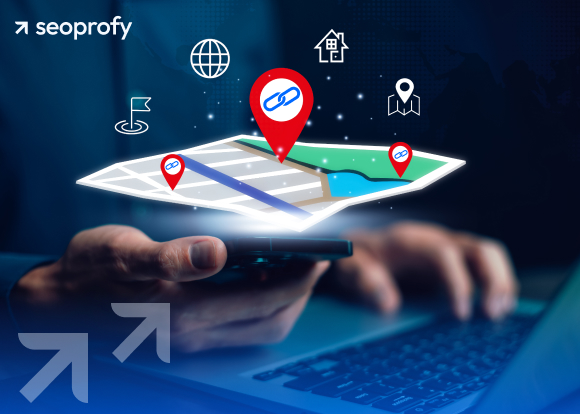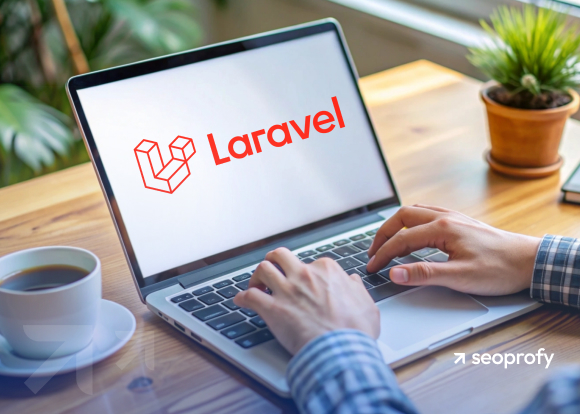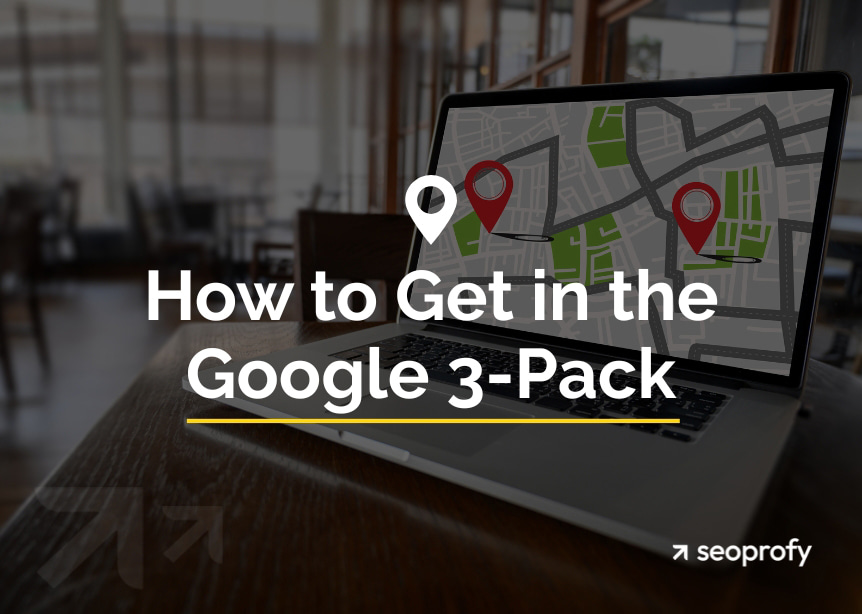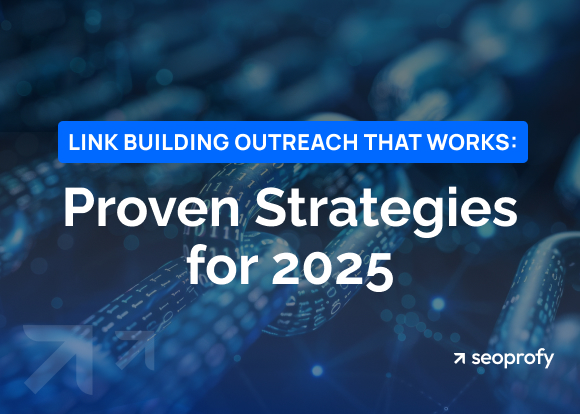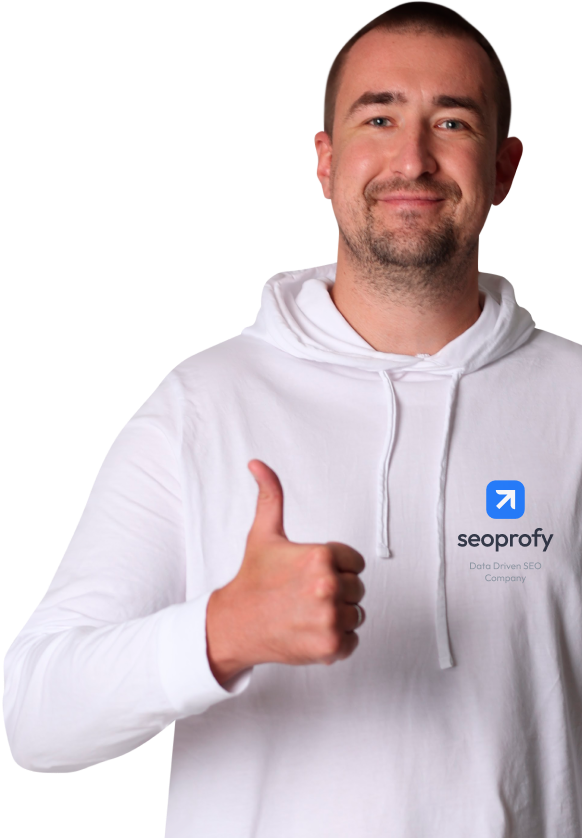You’ve updated your website. Your Google Business Profile is spotless. Still not in the Local Pack? It might be because you’re skipping link building for local SEO, and Google doesn’t see your business as authoritative in your area.
Links from local sites act as a trust signal. They improve your rankings and help you surpass competitors in search results. Want to know how to get local backlinks? In this article, we’ve gathered only those tactics that have been proven in practice and deliver results.
- Google considers local signals for ranking in Maps, including physical proximity, reviews, and geo-specific links.
- Regional link building strengthens your position in the region and helps you land in the Local Pack.
- On average, 125 high-quality links from trusted regional sites are sufficient.
- Analyzing competitors’ links helps identify platforms that work.
What Is Local Link Building?
Local link building is the process of acquiring references from websites that are geographically connected to your business. These can include local business directories, regional media outlets, or websites of organizations and events.
Unlike general link building strategies, the focus here is not only on the relevance of the source site’s topic but also on its physical or regional connection to your target area. The goal is to demonstrate that your business is actively operating in a specific region.
The Importance of Link Building for Local Companies
Your competitors are already investing in local seo link building. To avoid falling behind, it’s important to allocate a budget for getting mentions, not just for the website and its content. Below are the key benefits that come from investing in local links.
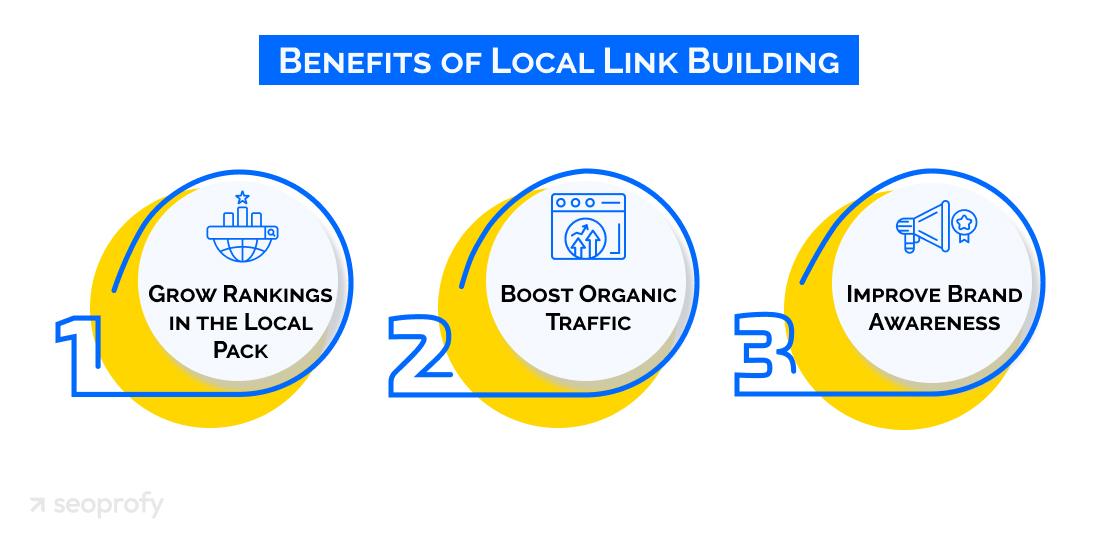
Increased Chances of Appearing in the Local Pack
Around 80% of local customers rely on search engines when looking for products or services nearby. For them, Google often displays a special block with a map and three businesses. This is called the Local Pack. Sometimes, users see a fourth “sponsored” business in the Map pack results:
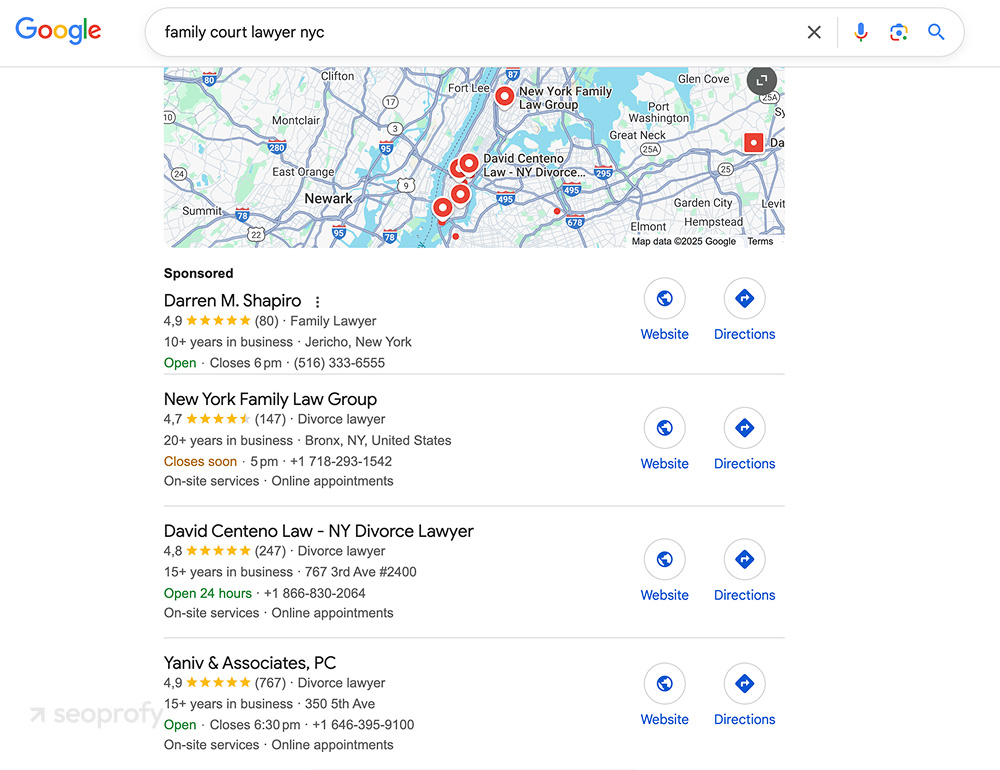
The search engine ranks these results based on physical proximity, reviews, and local authority. To analyze visibility in the LP across different locations, many professionals use Local Falcon. This tool shows how rankings vary based on where the user is searching from.
Growth in Organic Traffic From Geo-targeted Queries
Some regional queries don’t trigger the Map, but in the organic results, Google still relies on local SEO ranking factors like backlinks and other geo-specific signals. The more of these you have, the higher the relevance, and the better the rankings for location-focused keywords.
Local Links Enhance Brand Awareness
When a business appears on familiar regional platforms, its name becomes more recognizable. People start to notice it more often, remember it, and are more likely to click the link with its name.
Additionally, it can indirectly affect behavioral signals. If a user clicks on a reference from a local portal, spends time on the site, and completes a conversion, it strengthens the overall behavioral metrics. While not direct rating factors, such signals can contribute to improvements in organic and Map Pack rankings over time.
How Many Local Links Do You Need?
In local SEO, you don’t need thousands of backlinks to see results. Still, even a well-researched average won’t apply to every case. Let’s break down why.
The number of referring domains required to break into the top results depends on many factors:
- Industry
- Competitiveness of the keyword
- Intent behind the query
- Link profiles of competitors.
To show just how much things can vary, our team analyzed 10 local keywords across different industries. For each one, we looked at monthly search volume, keyword difficulty, and the average number of unique referring domains among the top 10 results:
| Target keyword | Volume | KD | Average DR | Average Referring Domains |
| personal injury lawyer chicago | 2900 | 76 | 51 | 503 |
| immigration lawyer seattle | 1000 | 41 | 33 | 112 |
| hvac sacramento | 900 | 52 | 64 | 158 |
| plumber sacramento | 500 | 24 | 54 | 59 |
| lawyer new york | 150 | 35 | 85 | 70 |
| auto repair minneapolis | 100 | 37 | 55 | 61 |
| family lawyer boston | 80 | 26 | 48 | 65 |
| nannies houston | 250 | 3 | 46 | 72 |
| cleaning services buffalo | 30 | 22 | 39 | 69 |
| barbershop in las vegas | 21 | 80 | 60 | 78 |
While the average sits at 125 referring domains, that doesn’t tell the whole story. To rank for “personal injury lawyer chicago,” you’ll need a much stronger backlink profile. Meanwhile, “auto repair minneapolis” requires far less to compete.
If you want a realistic benchmark for your specific case, open one of the best SEO tools, Ahrefs. As part of your local SEO keyword research, enter your target query into Site Explorer and check how many referring domains the top-ranking pages have.
How to Build Local Links: 13 Best Strategies
Over the past 13 years, our team has tested dozens of approaches to local link building. Some delivered great results, while others drained the budget with no return. In this section, we’ve compiled only the best practices that truly work for SEO. They are scalable, provide consistent results, and have been tested on multiple projects.
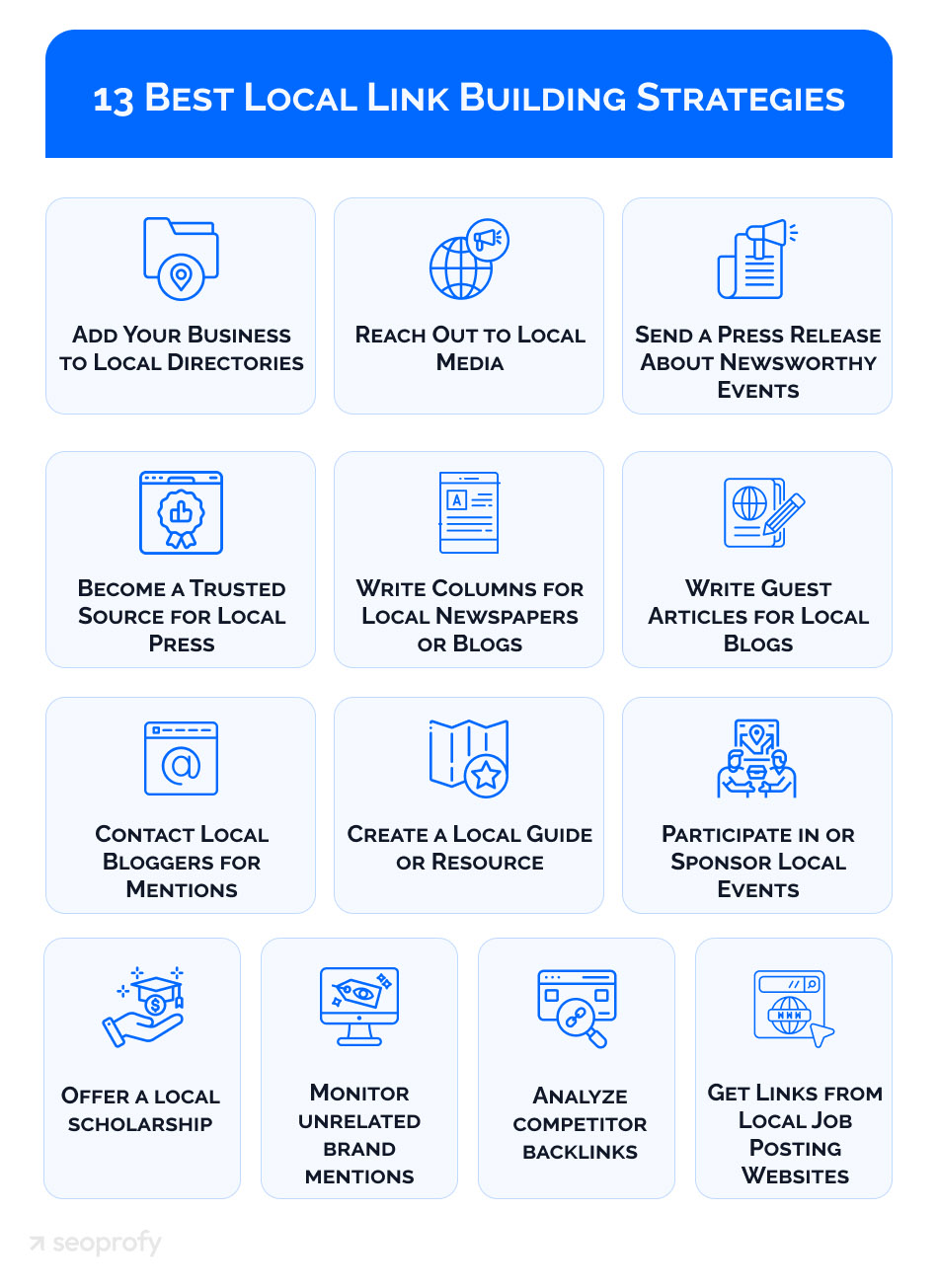
1. Add Your Business to Local Directories
Local directories are websites that collect information about businesses in a specific city or area. Listing your business in these directories helps Google confirm its legitimacy and associate it with a particular location.
To get started, submit your site to major platforms like Yelp, Nextdoor, and Foursquare — ideally during the initial SEO campaign setup. Once you’ve covered the main platforms, move on to region-specific directories. For example, if you’re targeting NYC, you might consider niche platforms like TalkNewYorkCity.com or similar local resources.
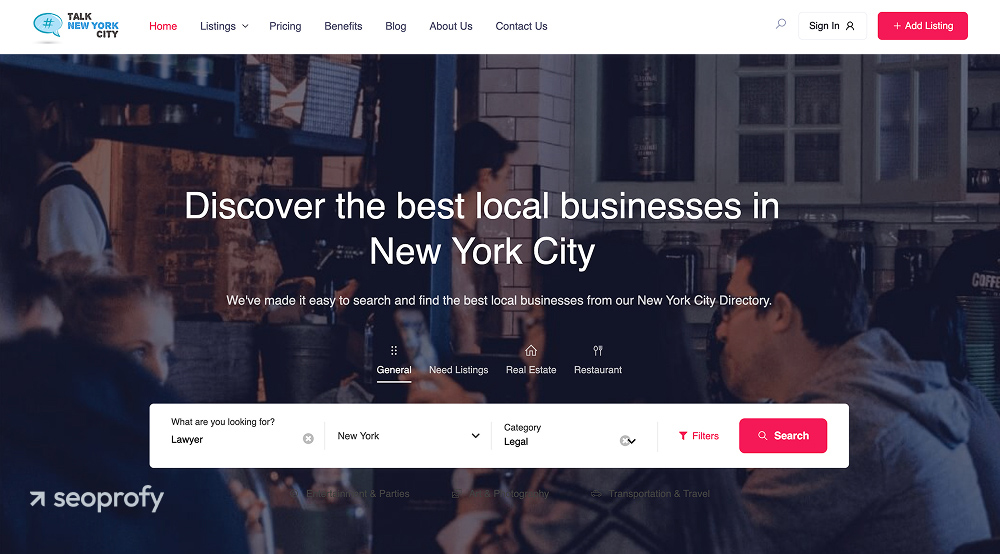
For this information to be effective, it must be accurate and match what’s listed on your website and Google Business Profile. There should be no discrepancies in your NAP (business name, address, or phone number) across all platforms.
2. Reach Out to Local Media
Publishing in regional media is a great way to not only get high-quality placements but also gain some traffic. These local citations are often editable, placed in context, and can pass authority.
Each region has its own platforms, and they need to be found manually. As an example, we’ve analyzed what’s available in Los Angeles. Some options are:
- LA Weekly, which regularly publishes lists of local entrepreneurs
- Spectrum News 1 SoCal, which features segments about small businesses
- The Eastsider LA and LAist, which cover local initiatives and community projects.
One of the most effective local link building tips is to focus on platforms that are both local and niche-specific. These give you the strongest relevance.
To get a backlink, prepare a concise, clear email with a topic that would interest their target audience. Keep in mind that many platforms may want to charge for placements.
Another option is collaborating with specialists offering regional link building services and digital PR. Thus, you won’t have to handle outreach and pitch preparation.
With SeoProfy, your business gets placements on websites that matter in your region. Our local link building service includes:
- Manual outreach to websites in your niche
- Geo-targeted backlinks placed in relevant content
- Detailed reports with all live links
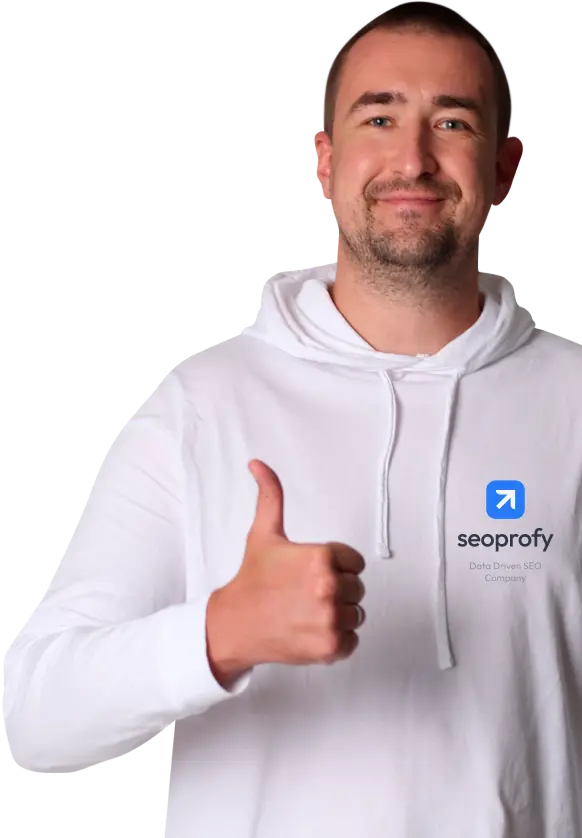
3. Send a Press Release About Newsworthy Events
A press release publication can lead to a link, which can also impact brand recognition and local visibility. However, this only works if there is a real newsworthy event.
This can be the opening of a new location, participation in a city program, the launch of a unique service, or local partnerships with well-known companies. Here’s an example of such a press release:
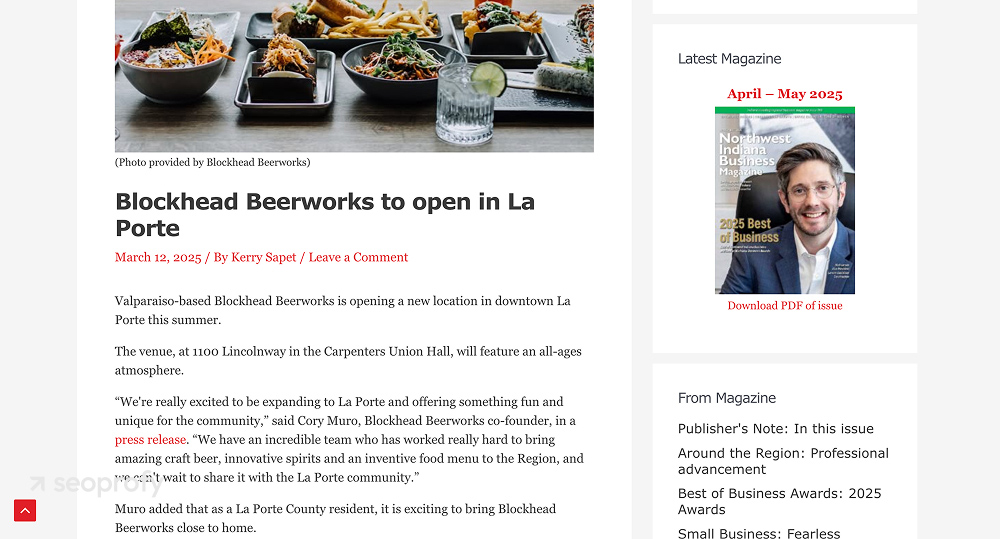
You can submit the release via specialized services like EIN Presswire. After publication, monitor whether local news sites have covered it and whether they’ve included a link to your site.
If you want to improve your chances, send the release directly to the editorial team. Local journalists often respond better to direct contact. Keep in mind that they may ask you to pay for creating content or inserting a reference (or both). This is common with certain local link building tactics.
However, this isn’t always necessary. Companies that have been offering local SEO services for a long time, with established relationships in various media outlets, often get these links for free or on mutually beneficial terms like co-promotion, content-for-reference collaborations, or even the occasional gray-area link exchange.
4. Become a Trusted Source for Local Press
Journalists are constantly looking for experts to comment on various topics. If you become such a source, you can receive mentions and links from area-specific media with minimal effort.
Outside the local context, this method also works well for ecommerce link building. It’s just as useful for SaaS companies and service businesses where brand credibility and subject-matter expertise influence the purchase decision.
The go-to platforms for this are Qwoted, Terkel, and Featured. The process is simple: you register, track topics in your niche, and offer a concise, relevant comment. Alternatively, you wait for a journalist to select you from the expert database:
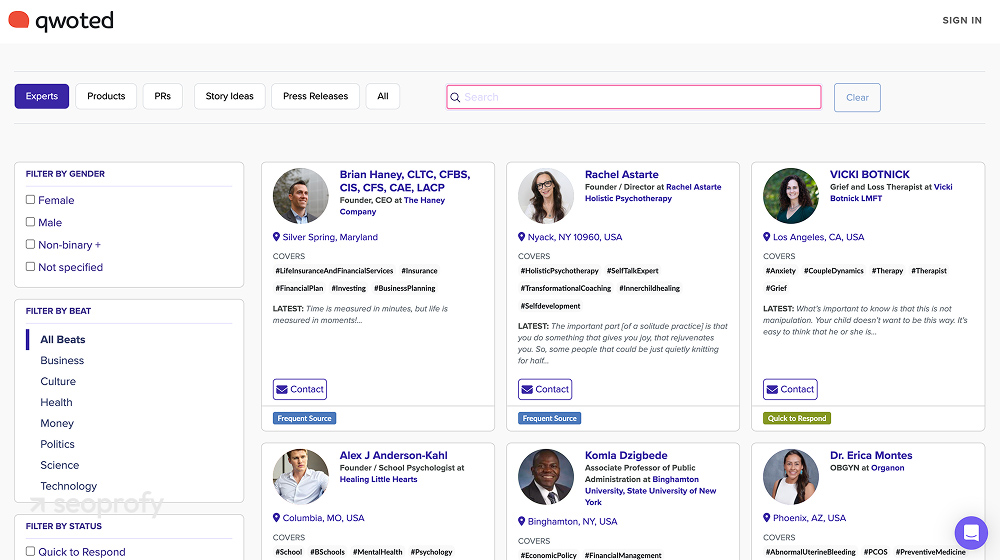
Over time, some editors start reaching out directly. This is one of the few local link building opportunities that don’t require investing in direct outreach.
The advantage of this strategy is that journalists from both area-specific and major publications, such as the New York Times or Forbes, are often present on these platforms. If you’re lucky, you might get the best backlinks for local SEO that’s difficult for your competitors to replicate.
In link building for local businesses, this kind of exposure can offer both authority and reach, but it comes with limitations. Most of the time, you’ll only get a reference to your homepage (can be partially addressed by redistributing weight through internal links). Additionally, many comments end up not being published. However, if you’re using a pay for performance SEO model, this isn’t a concern, as you only pay when the mention actually goes live.
5. Write Columns for Local Newspapers or Blogs
If you are an expert in your field, offer to write a column for a local publication. This could be a news site, a blog, or an online newspaper. In your articles, you can naturally mention your website, service, or case study.
This is also a form of local content marketing that helps drive traffic and build authority. For example, a lawyer could write about typical landlord disputes or explain family law nuances for the state. And while this approach can work across different industries, these types of articles work especially well as part of link building for law firms.
For example, H. Dennis Beaver, Esq. writes the “You and the Law” column, published on several California platforms, including Kiplinger. Also, on a more localized level, Taylor Smith, a lawyer representing the South Carolina Press Association, writes a column for local news websites discussing legal issues related to the media:

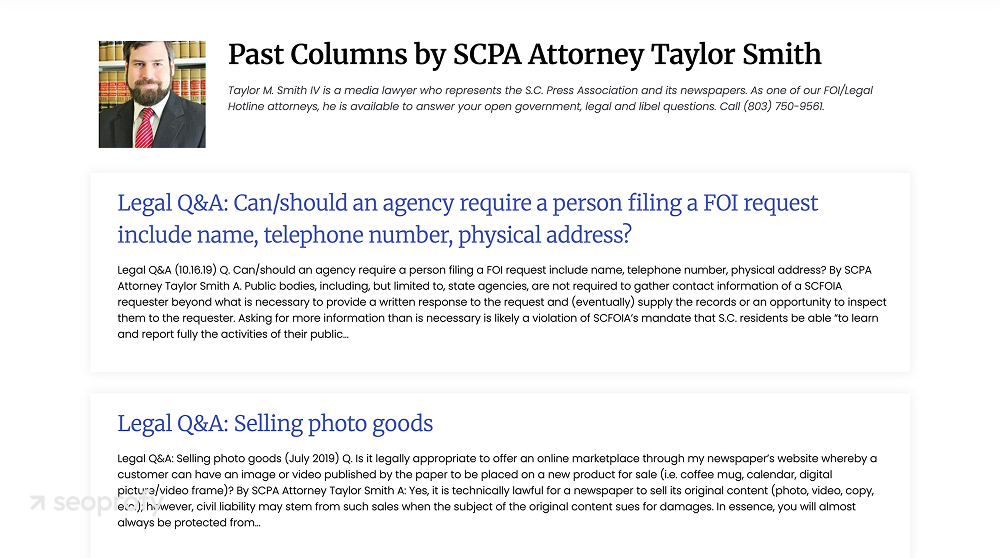
6. Write Guest Articles for Local Blogs
Guest posts allow you to get links from regional resources, even if the platform doesn’t offer a regular column format. Find blogs and websites that publish content on your topic and offer a useful article with a regional focus and your reference.
To do this, search Google for queries like “your topic” plus “guest posting” or “write for us” along with the city or region. While it will be harder to find truly local websites for posting compared to national ones, it’s worth trying. Take a look yourself:
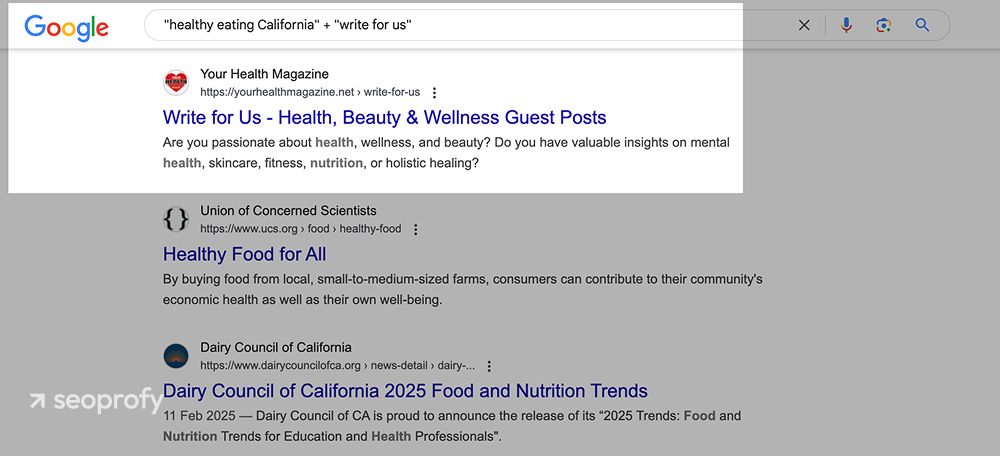
Check out blog sections on the websites of local agencies, community portals, and niche projects. Often, these sites don’t publicly advertise the option to publish, but they’re happy to accept articles if the proposal is well-thought-out. However, you’ll need knowledge of outreach methods.
7. Contact Local Bloggers for Mentions
Links from local blogs can bring more than just SEO benefits. They can also drive real traffic, especially if the blog is run by an active author with a strong following in your city or niche.
While developing an SEO strategy, you should already start looking for authors to collaborate with. You can find them via location-based search queries, social networks, or by analyzing competitors’ backlinks. Instead of just asking to be mentioned, offer to showcase your value to their audience through:
- A service review
- A customer experience story
- Participation in a local event
Moreover, such links will often perform better than a directory listing. For example, FasterCapital shared a case where a restaurant invited food bloggers to sample dishes and write about it on their platforms. They reported a 50% increase in foot traffic over the next month. So, local influencer collaborations can lead to excellent conversion rates.
8. Create a Local Guide or Resource
A useful area-specific resource can naturally attract backlinks. This could be a neighborhood guide, a list of trusted suppliers, or a collection of events.
Moreover, such a resource can be offered in partnership with local websites, bloggers, forums, or even news outlets. For example, The Drake Hotel in Chicago, Illinois, provides such a guide:
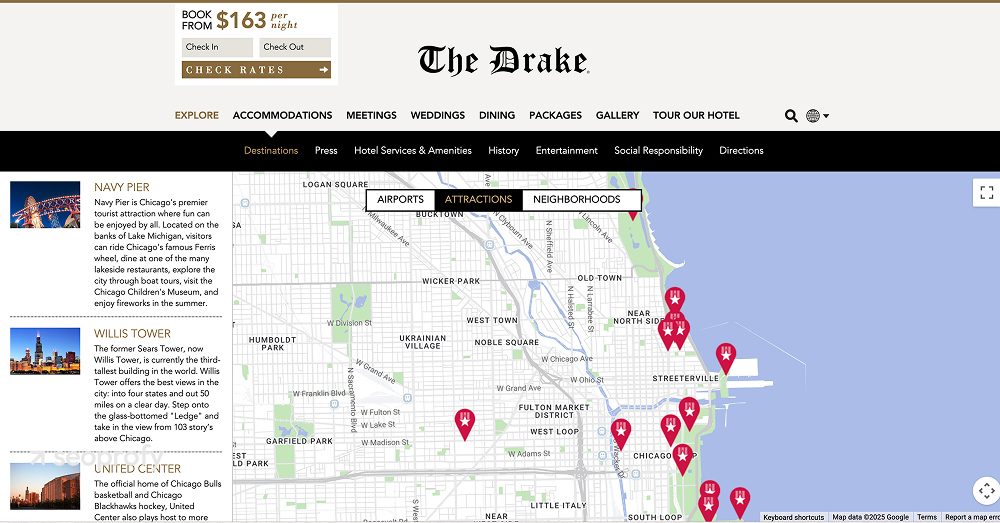
In the long run, this can be a more scalable option that may work better for local organic rankings than a standard guest post. The links appear naturally, without outreach or formal agreements, and fully align with white-hat SEO practices.
9. Participate in or Sponsor Local Events
Participating or sponsoring area-specific events helps to earn backlinks from the organizers’ websites. These can be city festivals, business expos, charity events, or industry conferences. It’s one of the most effective local link building tips when your brand is visible both online and on-site.
For example, on the website of the “Peak Performance” fitness center in Denver, Colorado, there is a whole page dedicated to the partners of their programs. Each sponsor got a link:

Such pages are often well-indexed and remain on the web for a long time. However, aside from the SEO benefits of local link building, it’s also one of the best ways to establish strong connections.
10. Offer a Local Scholarship
Establishing your own scholarship is a reliable and almost guaranteed way to get backlinks from authoritative sources, including school, college, and university websites. These domains often end in .edu and carry very high SEO value. Even one such reference can push your site much closer to the top of local search results.
For this to work, create a dedicated page with the terms. Then, distribute the information to educational institutions in your region. Many of them publish lists of current scholarships, and thus, you’ll get a mention.
A great example of this technique is the Busey Bank Bridge, which offers scholarships to students residing in the counties it serves. Through this initiative, they managed to get backlinks from .edu domains to their dedicated page:
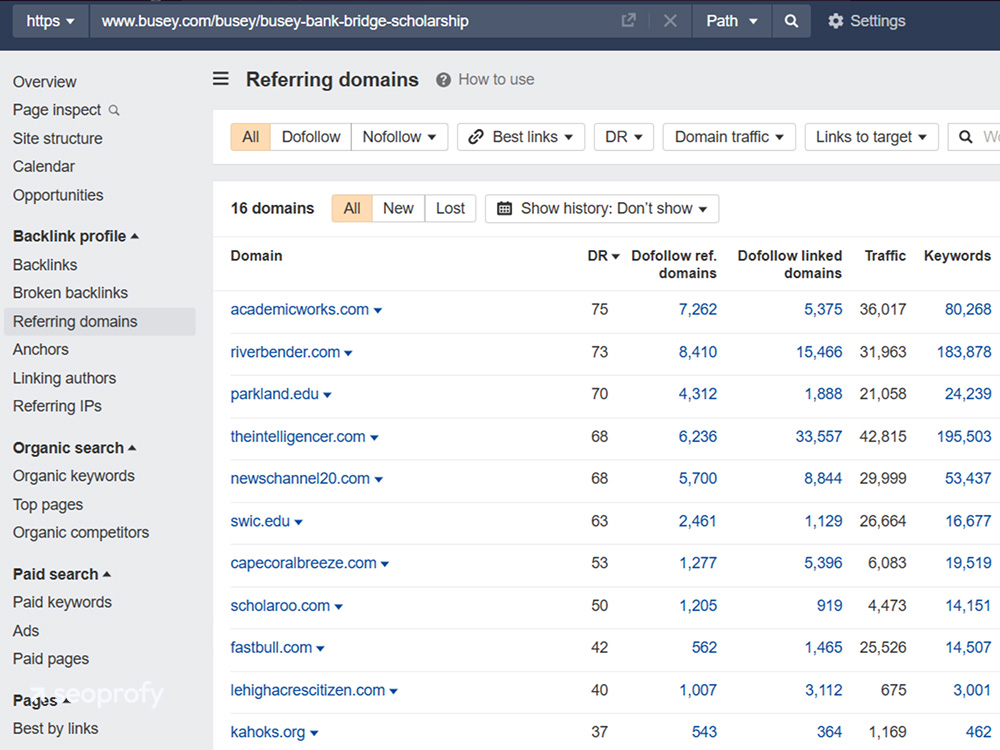
11. Monitor Unlinked Brand Mentions
If your brand is mentioned without a link, it’s a missed opportunity. Such mentions can be found and turned into quality references with minimal effort. It’s not the first step, but once your business has some visibility, it’s one of the most practical local link building ideas.
To find them, use tools like Ahrefs, Semrush, or BrandMentions. In Ahrefs, open the Content Explorer tool, enter your company name in quotes, and then filter the results by selecting “Highlight unlinked domains.” This will show you sites that mention your brand but don’t link to it. Alternatively, the new Brand Radar feature on the site also helps perform that.
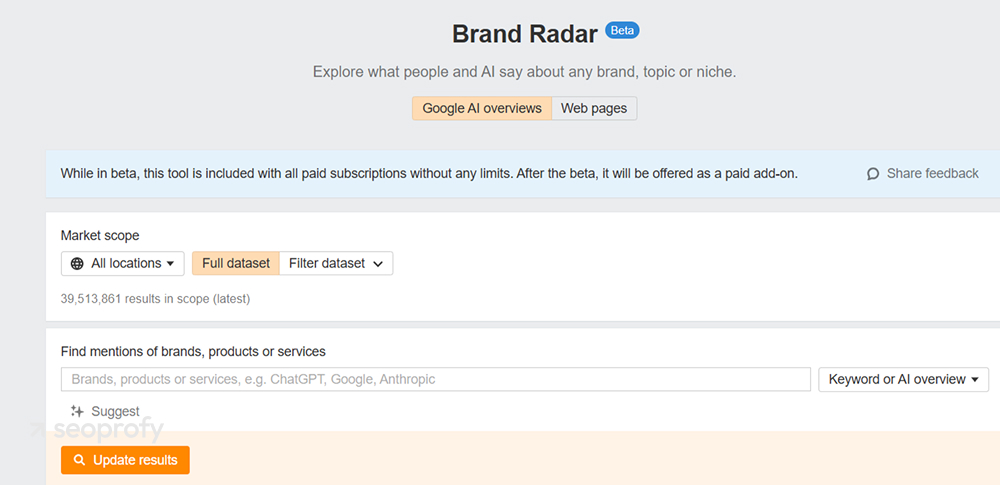
In Semrush, a similar process works with the Brand Monitoring tool. Set the filter to “without link.” Next, manually check if the reference is missing. If it is, find a contact related to the site (using Hunter.io works well) and send an email proposing to add a link.
However, be aware that often a fee may be requested for the placement, even though your brand is already mentioned. These small but recurring expenses can quietly add up and should be factored into your overall SEO costs.
12. Analyze Your Competitors’ Backlinks
Competitor analysis helps identify effective platforms and replicate successful local link building tactics. It’s one of the fastest ways to understand where backlinks are really being earned in your niche.
Let’s say you have a law firm in New York. As a hypothetical competitor, let’s choose the site nyccriminalattorneys.com. By using tools like Ahrefs, SEMrush, or similar, you can track how quickly they are building backlinks. For instance, here’s their growth month by month:
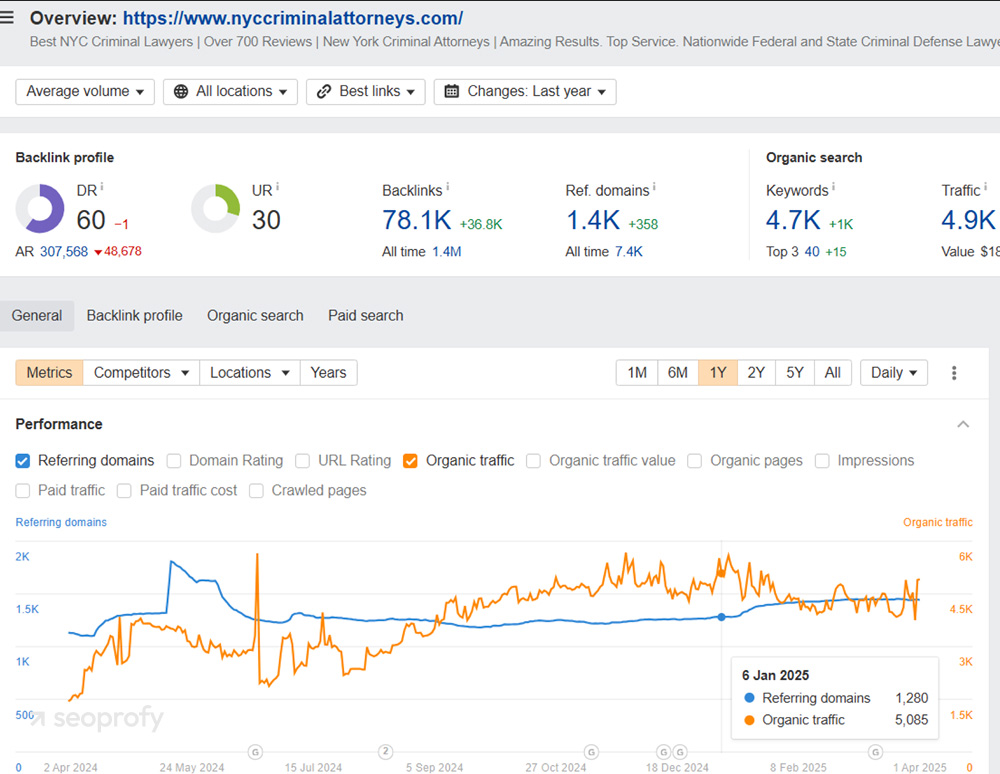
Next, you can export their best backlinks. This way, you’ll see the best options for placements:
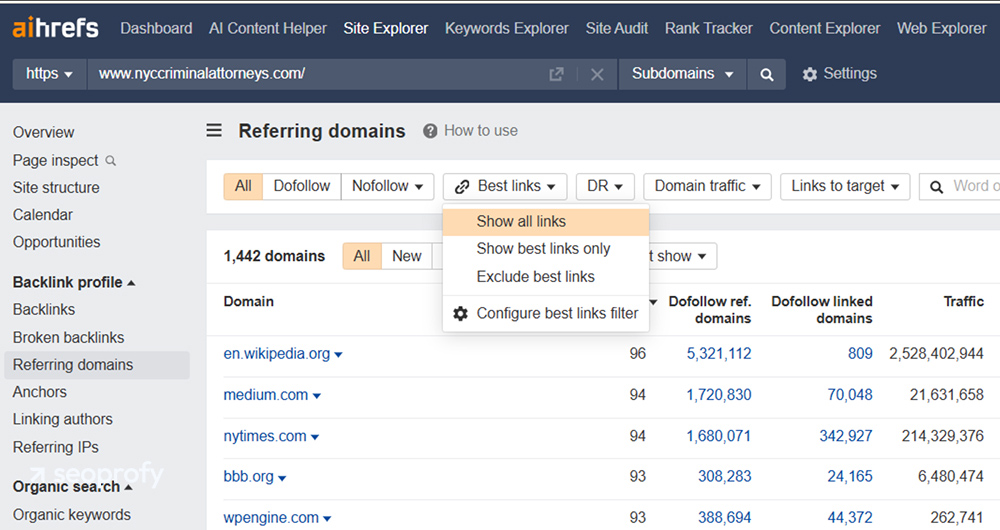
It’s also clear that they’re purchasing other sites and setting up 301 redirects to their pages. This helps strengthen their backlink profile:
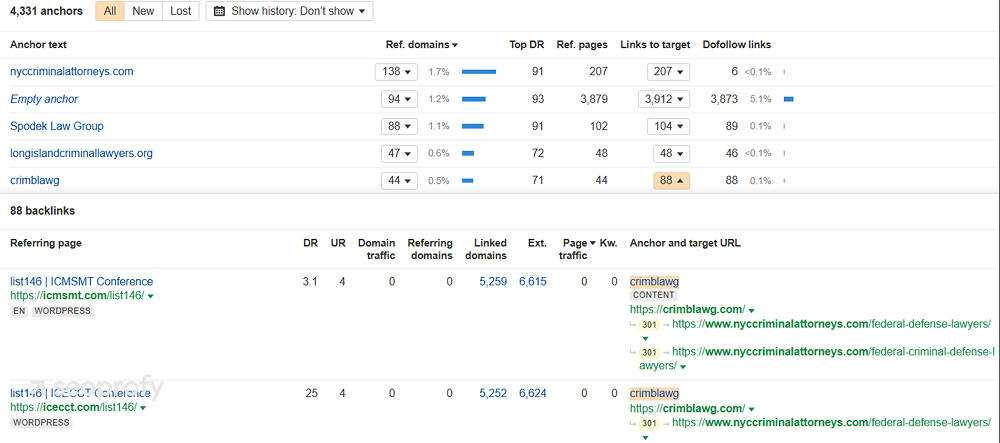
Look at what pages of other local businesses are getting the most backlinks. This insight is useful not only for content planning but also for SEO goal setting, helping you prioritize pages with the highest link potential:
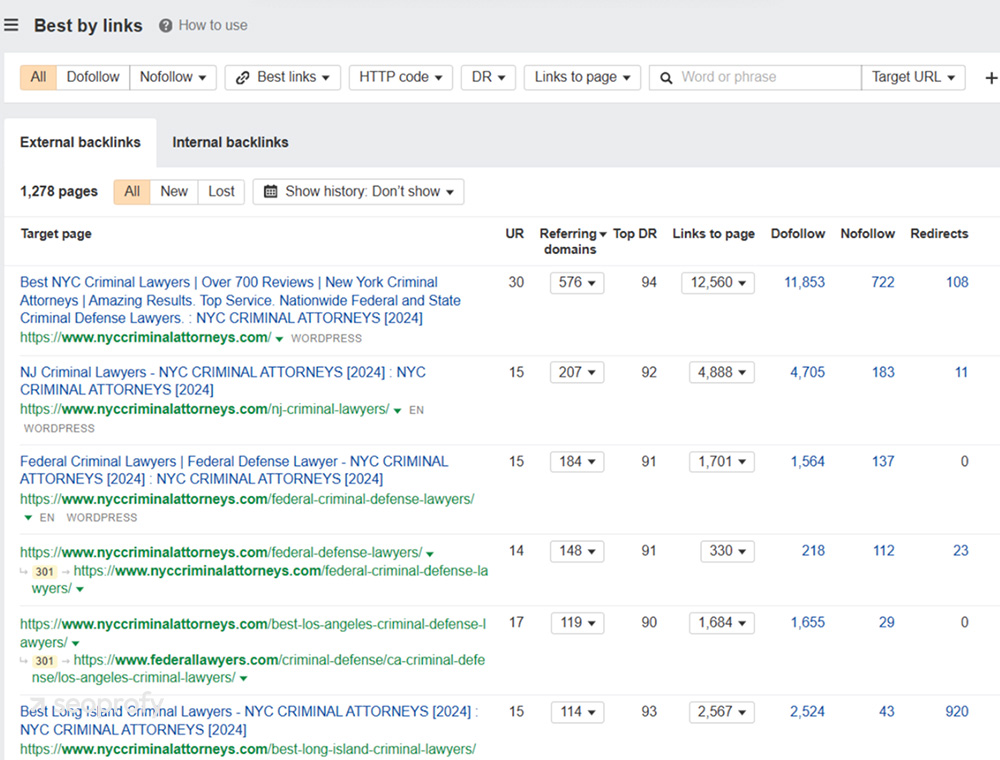
If a competitor’s backlink strategy is working and helping them rank higher locally, you can recreate it. Start with references that are easy to replicate and then move on to more challenging ones: media mentions, partner publications, and collaborations.
13. Get Links from Local Job Posting Websites
Posting job openings on local websites is a simple way to get natural placements on trusted domains. Most of these platforms include a link to the employer’s website, which provides additional visibility.
Start with universities in your region. Many of them publish job listings from local businesses. For instance, if you’re located in Philadelphia, you can post a vacancy on platforms like Handshake for Temple University or the University of Pennsylvania. Also, look for regional job boards like LAJobs or NYC.gov Jobs, depending on your state.
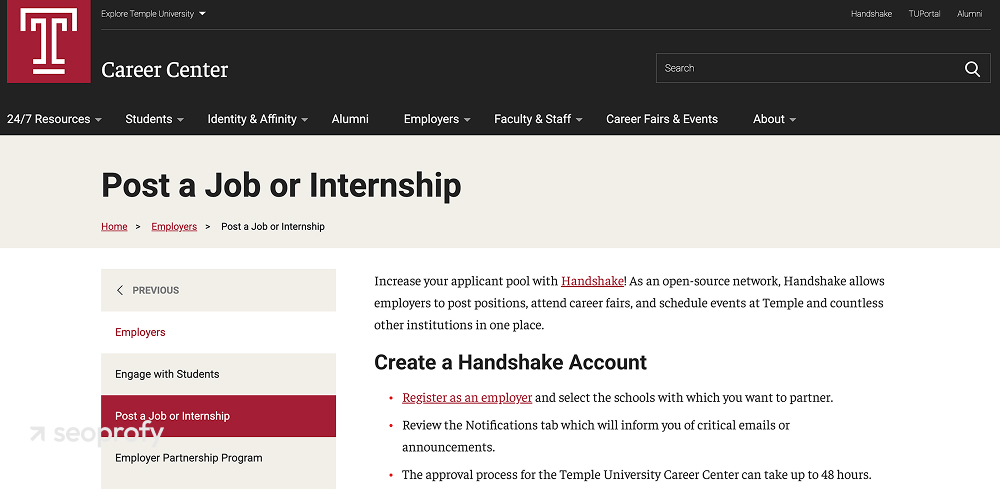
Even if the job listing is only live for a couple of weeks, the page can remain indexed for a longer period. These links appear organic and may even come from .edu or .gov domains, enhancing their authority. While they’re not the most obvious tactic, they can quietly contribute to the long-term ROI of SEO.
5 Mistakes to Avoid in Local Link Building
Even with a good budget and clear strategy, it’s easy to waste resources if you ignore common mistakes in geo-targeted link building. Here’s what often goes wrong:
Ignoring Geographical Relevance
Placing links on general-topic sites that aren’t tied to your region doesn’t send a local signal. If your business operates in Austin but mentions come from sites in New York, it’s ineffective for the LP. The priority should be websites connected to your location.
Focusing on Quantity Over Quality
Believing that more placements always mean better rankings is still a widespread SEO myth. Links from irrelevant, outdated, or blatantly spammy platforms don’t yield results. In local SEO, it’s not about quantity but rather regional relevance and thematic alignment. Five strong placements are far more valuable than a hundred from directories with zero traffic.
Blindly Trusting Metrics
Tools like Ahrefs and Semrush are essential for link analysis, but the numbers in the reports don’t tell the whole story. Sometimes, a domain looks trustworthy, but the backlink is placed in the footer, on an archived page, on a low-traffic page, or in a section closed to indexing.
These nuances can only be spotted through manual checking, which is especially important in link building for regional SEO where relevance and placement matter more than raw metrics. In our SEO case studies, you can see how often we remove spammy placements through disavow, as it’s better not to have them in the profile at all.
Ignoring Natural Link Growth
Links are a key ranking factor, so it’s vital to build your profile actively. But they shouldn’t appear all at once, especially if they’re loosely related or placed on similar types of pages. Google algorithms track anomalies and may lower the site’s rank if the growth looks artificial. In more serious cases, this can even lead to manual actions, which often require Google penalty recovery services to fix.
Not Tracking Changes
Local links can disappear over time. Websites shut down, pages are deleted, and domains change owners. Without regular audits, you may not notice that half of your placements have vanished. This also makes it harder to measure SEO progress accurately.
Boost Your Local SEO Today
Local link building requires flexibility. There’s no universal list of sites that every business must be on. In one region, it might be a blog with a few active readers, while in another, it could be a regional directory. So, this approach doesn’t boil down to a set list of actions.
Often, backlink strategies are hard to scale and automate. It requires time, experience, and a clear strategy to succeed. But you can delegate these tasks to an outsource SEO team. SeoProfy works with area-specific projects worldwide. We know how to find platforms that work in your region and how to build local link building strategies that deliver results.

